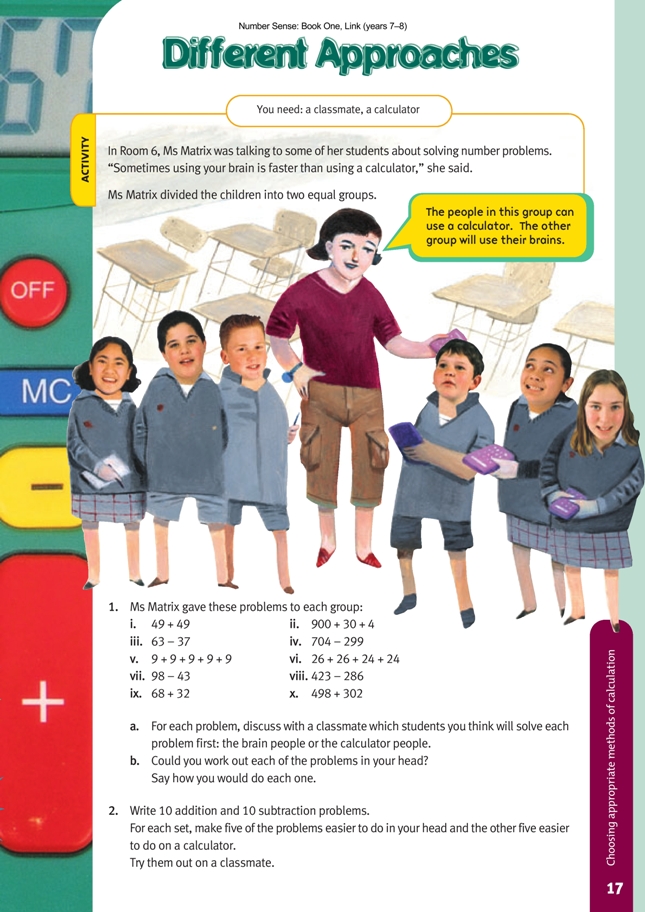This is a level 3 number activity from the Figure It Out series. It relates to Stage 6 of the Number Framework.
A PDF of the student activity is included.
Click on the image to enlarge it. Click again to close. Download PDF (628 KB)
choose a mental strategy to solve an addition problem
choose a mental strategy to solve a subtraction problem
FIO, Link, Number Sense, Book One, Different Approaches, page 17
A calculator
The purpose of this activity is to encourage the students to improve their mental strategies so that they can mentally solve addition and subtraction problems quickly. The contest between the calculator users and the brain users is not about showing that one of these approaches is better than the other. The calculator approach is there as a benchmark to show the efficiency of a good mental strategy. There is not one “correct” strategy; a good one is one that finds the answer quickly.
As part of the discussion in question 1a, ask the students what knowledge or strategy the “brain” people might need to use to beat the “calculator” people.
You might need to point out that the calculator people would have been expected to use key presses only, as indicated by the question, and would not have combined their own mental strategies with the calculator to speed up their response. For example, in problem 1v, they would have been expected to press
9 + 9 + 9 + 9 + 9 = , not 5 x 9 = .
In problem 1b, the students should be encouraged to adjust the numbers or the operation in ways that will give them accurate solutions quickly.
Strategies such as rounding or adjusting would suit question 1i, where 49 can be thought of as the “tidy” number 50 and then adjusted by taking 2 from the answer. Question 1ii can be worked out quickly if the students recognise that the digits are expanded to show their place value, so the quick solution is simply expressing it as the compact numeral 934. Question 1iv encourages the use of compensation to see that 704 – 299 is the same as 705 – 300. The students could then also round 705 to 700 as long as they remember to insert the 5 into the answer. Question 1v will be easy for those students who understand that a repeated addition sequence is equivalent to a multiplication situation.
Question 2 asks the students to apply their understanding of mental strategies to create questions that are suited to mental reasoning versus calculator usage. To make questions suited to mental thinking, they should be looking to select:
• numbers that can be easily rounded to a tidy number (a number with a zero on the end)
• numbers that can be joined to make a ten or a hundred
• equations that look hard but are easy when a simple adjustment is made to them
• equations that involve doubles or near doubles
• equations that involve addition of repeated groups.
Make sure that the questions that the students create are not just basic facts because these are likely to only involve recall thinking as opposed to strategy thinking.
For the questions designed to suit the calculator people, you may need to specify the number of digits to be used in each numeral so that the students don’t just resort to very long numerals to try and make the questions difficult. Encourage the students to use the opposite to the ideas used to make questions designed for the brain people to win. Have the students list the strategies they see the brain people using to beat the calculator people on the questions designed for them to win. On the questions that favour the calculator use, the students should explain what it is about the questions that makes it hard for brain people to solve them quickly.
Answers to Activity
1. a. Discussion will vary. See comments in b below.
b. i. In the head is easy: 50 + 50 = 100,
so 49 + 49 = 98.
ii. You can do this in your head using standard
place value: 900 + 30 + 4 = 934.
iii. Easy on a calculator, but it can also be done
easily in your head:
63 – 40 = 23, so 63 – 37 = 23 + 3 = 26
or 63 – 37 = is the same as 37 + = 63;
37 + 3 + 23 = 63
so 37 + 26 = 63
and 63 – 37 = 26.
iv. 704 – 300 = 404, so 704 – 299 = 405
v. 9 + 9 + 9 + 9 + 9 = 5 x 9
= 45
or 10 + 10 +10 +10 +10 = 50, so 9 + 9 + 9 + 9 + 9 = 50 – 5 = 45
vi. 26 + 24 = 50
so 26 + 26 + 24 + 24 = 100
vii. 98 – 43 = 55 (standard place value)
8 – 3 = 5
90 – 40 = 50
50 + 5 = 55
viii. 423 – 286 is probably easier on a calculator, but it can be done in the head:
286 + 14 = 300
300 + 123 = 423
123 + 14 = 137
ix. 68 + 32 = 100 (8 + 2 = 10, 60 + 30 = 90, 10 + 90 = 100)
x. 498 is 2 fewer than 500.
500 + 302 = 802
so 498 + 302 = 800
or 498 + 302 = 500 + 300
= 800 (compensation)
2. Problems will vary.
